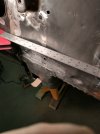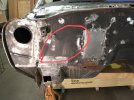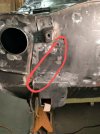OK, I'll try my best.
Robert first, #1 There are 12 evenly spaced 5/32"plug welds around the perimeter of the plate which was clamped to the firewall with long vise grips for welding the plugs. I was very careful with the heat.
Heat from welding will result in the weld and HAZ area to shrink as it cools. Whether you are using sheet metal or 1" thick plate steel, it shrinks. If this were caused by weld shrinkage, which makes sense, then simply planishing each plug weld with a hammer and dolly should stretch them back out and lessen the "dent" as those welds shrink they will gather surrounding metal along for the ride.
#2 Relief cuts were about a 1/4" deep in just the corners so just a tack to fill them in.
Again, more shrinking. I was thinking perhaps the unfolding of the sheet metal had caused some distortion, and that is still a possibility. The defect is quite a ways apart from the welds, but if there was a slight low there to start with, the weld shrinkage would easily add to the issue.
#3 Sadly, I can't say if the oil canning was present before the welding. But, the slight crease was there from the beginning and a low area that I made worse.
This is a good learning moment, my suggestion is to fix any defects prior to welding in a patch, whether that be a fender, firewall, or whatever. It's difficult enough as is to keep distortion at bay while welding. Try to eliminate any other defects before welding so they don't add to the problem/confusion
anotheridiot, Yes it is oil canning. It takes a bit of effort but it will pop in and out. There is kind of a dent (crease) originating from the lower corner where the main firewall is spot welded to the left fresh air "box", Most of this area in question was covered by the OE heater/ac box.
It seems as the body was being assembled on the jig some "adjustments" were made during the fit up.
FWIW, the car was damaged in the right front fender prior to me owning it. I don't think it was bad enough to bend the firewall.
At least the fender mounting points don't appear to be pushed out of shape.
For lack of a better description, the area to the left (pass. side) of the old opening seems to be under a good amount of tension (pressure) sideways and can't relax.
I've considered a 1/32" slice along the area of the spot welds in an effort to give the metal somewhere to go.
I'm not a fan of implementing "fixes" to the results, I prefer to address the cause. So IF shrinking caused the issue, stretch the welds. If this defect pre-existed as excess metal (perhaps it was from the fender damage), then perhaps some shrinking of the "excess" metal is in order. At the end of the day, your vehicle, your choice on the repair. I would suggest fixing results and not causes doesn't help you to understand how these issues arise or promote logical, systematic methods to keep those issues in check.
Don, I've never used a shrinking disc and feel it's beyond my capabilities.
Thanks everyone, I'm honored that you took the time to try to help. K.Lee



